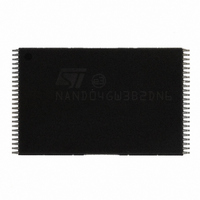NAND04GW3B2DN6E NUMONYX, NAND04GW3B2DN6E Datasheet - Page 48

NAND04GW3B2DN6E
Manufacturer Part Number
NAND04GW3B2DN6E
Description
IC FLASH 4GBIT 48TSOP
Manufacturer
NUMONYX
Datasheet
1.NAND04GW3B2DN6E.pdf
(72 pages)
Specifications of NAND04GW3B2DN6E
Format - Memory
FLASH
Memory Type
FLASH - Nand
Memory Size
4G (512M x 8)
Interface
Parallel
Voltage - Supply
2.7 V ~ 3.6 V
Operating Temperature
-40°C ~ 85°C
Package / Case
48-TSOP
Lead Free Status / RoHS Status
Lead free / RoHS Compliant
Speed
-
Lead Free Status / RoHS Status
Lead free / RoHS Compliant
Available stocks
Company
Part Number
Manufacturer
Quantity
Price
Company:
Part Number:
NAND04GW3B2DN6E
Manufacturer:
StarMicro
Quantity:
872
Company:
Part Number:
NAND04GW3B2DN6E
Manufacturer:
ST
Quantity:
5 645
Part Number:
NAND04GW3B2DN6E
Manufacturer:
ST
Quantity:
20 000
Software algorithms
9.3
9.4
9.5
48/72
Garbage collection
When a data page needs to be modified, it is faster to write to the first available page,
resulting in the previous page being marked as invalid. After several updates it is necessary
to remove invalid pages to free memory space.
To free this memory space and allow further program operations, the implementation of a
garbage collection algorithm is recommended. In garbage collection software, the valid
pages are copied into a free area and the block containing the invalid pages is erased as
show in
Figure 22. Garbage collection
Wear-leveling algorithm
For write-intensive applications, the implementation of a wear-leveling algorithm is
recommended to monitor and spread the number of write cycles per block.
In memories that do not use a wear-leveling algorithm, not all blocks get used at the same
rate. The wear-leveling algorithm ensures that equal use is made of all the available write
cycles for each block. There are two wear-leveling levels:
The second level wear-leveling is triggered when the difference between the maximum and
the minimum number of write cycles per block reaches a specific threshold.
Error correction code
Users must implement an error correction code (ECC) to identify and correct errors in the
data stored in the NAND flash memories. The ECC implemented must be able to correct 1
bit for every 512 bytes. Sensible data stored in the spare area must be covered by ECC as
well.
First level wear-leveling, where new data is programmed to the free blocks that have
had the fewest write cycles
Second level wear-leveling, where long-lived data is copied to another block so that the
original block can be used for more frequently-changed data.
Figure
Invalid
Valid
page
page
22.
Old area
(erased)
Free
page
New area (After GC)
NAND04G-B2D, NAND08G-BxC
AI07599B












